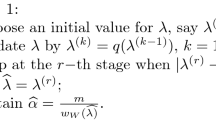Abstract
Adjusted empirical likelihood (AEL) is a method to improve the performance of the empirical likelihood (EL) particularly in the construction of the confidence interval based on completely observed data. In this paper, we extend AEL approach to the analysis of right censored data by adopting an influence function method. The main results include that the adjusted log-likelihood ratio is asymptotically Chi-squared distributed. Simulation results indicate that the proposed AEL-based confidence intervals perform better compared with normality-based or EL-based confidence intervals specifically for small sample size within the right-censoring setting. The proposed method is illustrated by analysis of survival time of patients after operation for spinal tumors.

Similar content being viewed by others
References
Chen J, Variyath AM, Abraham B (2008) Adjusted empirical likelihood and its properties. J Comput Graph Stat 17:426–443
Chen SX, Cui HJ (2007) On the second-order properties of empirical likelihood with moment restrictions. J Econom 141:492–516
Diciccio TJ, Hall P, Romano JP (1991) Empirical likelihood is Bartlett-correctable. Ann Stat 119:1053–1061
He S, Liang W, Shen J, Yang G (2012) Empirical likelihood for right censored lifetime data. arXiv:1203.5955v1.
Hall P, La Scala B (1990) Methodology and algorithms of empirical likelihood. Int Stat Rev 58:109–127
Imbens GW (1997) One-step estimators for over-identified generalized method of moments models. Rev Econom Stud 64:359–383
Kumazawa Y (1987) A note on an estimator of life expectancy with random censorship. Biometrika 74:655–658
Liu Y, Chen J (2010) Adjusted empirical likelihood with high-order precision. Ann Stat 38:1341–1362
Metcalfe S, Gbejuade H, Patel NR (2012) The posterior transpedicular approach for circumferential decompression and instrumented stabilization with titanium cage vertebrectomy reconstruction for spinal tumors: consecutive case series of 50 patients. Spine 37:1375–1383
Newey WK, Smith RJ (2004) Higher order properties of GMM and generalized empirical likelihood estimators. Econometrica 72:219–255
Owen AB (1988) Empirical likelihood ratio confidence intervals for single functional. Biometrika 75:237–249
Owen AB (1990) Empirical likelihood ratio confidence regions. Ann Stat 18:90–120
Qin GS, Zhao YC (2007) Empirical likelihood inference for the mean residual life under random censorship. Stat Probab Lett 77:549–557
Qin J, Lawless J (1994) Empirical likelihood and general equations. Ann Stat 22:300–325
Shen J, Liang W, He S (2012) Likelihood ratio inference for mean residual life. Stat Pap 53:401–408
Stute W (1996) The Jackknife estimate of variance of a Kaplan–Meier integral. Ann Stat 24:2679–2704
Tsao M (2004) Bounds on coverage probabilities of the empirical likelihood ratio confidence regions. Ann Stat 32:1215–1221
Wang QH, Jing BY (2001) Empirical likelihood for a class of functions of survival distribution with censored data. Ann Inst Stat Math 53:517–527
Acknowledgments
We would like to thank Nitin R.Patel for sharing his operation data with us and permitting us using our methods to analyze the data. We would also like to acknowledge the referees for their constructive and helpful comments and their comments led to substantial improvements in the manuscript. Research Supported by National Natural Science Foundation of China (11171230,10801003).
Author information
Authors and Affiliations
Corresponding author
Appendix
Appendix
Proof of Theorem 2:
To determine \(R({\theta }_0;a_n)\), we solve for the Lagrange multipliers \(\mu \) and \(\lambda \) in
Then \(\mu =-n-1\) and \(p_{i}=\dfrac{1}{n+1}(1+\lambda W_{ni})^{-1},\ i=1,2,\ldots ,n,\) where \(\lambda \) is the solution of
As \(W_{n{n+1}}\) and \(\overline{W}_n=n^{-1}\sum _{i=1}^nW_{ni}\) are on the opposite sides of 0, the solution of (6.1) exists.
The EL ratio of \({\theta }\) can be written as
Let \(\sigma ^2=Var(W_i)\) for \(W_i\) defined in (3.3) and \(\lambda \) be the solution of (6.1). We prove that \(\lambda =O_p(n^{-\frac{1}{2}})\).
Denote \(W^{*}={\max }_{1\le {i}\le {n}}|W_{ni}|\). From Lemma 4.3 in He et al. (2012), we have
Let \(\rho =|\lambda |, \hat{\lambda }=\lambda /\rho \). Multiplying \(n^{-1}\hat{\lambda }\) to both sides of (6.1), we have
Using \(a_n=o_p(n)\) and (6.3), we get
It follows that \(\rho =|\lambda |=O_p(n^{-1/2})\).
Denoting \(\hat{V}_n=n^{-1}\sum _{i=1}^{n}W_{ni}^2\), we get
As \(n\rightarrow {\infty }\), we have \(\lambda =\hat{V}_n^{-1}\overline{W}_n+o_p(n^{-\frac{1}{2}})\).
Finally, we use Taylor expansion for \(l(\theta _0;a_n)=-2\log R(\theta _0;a_n)\) and have
Using \(\lambda =\hat{V}_n^{-1}\overline{W}_n+o_p(n^{-\frac{1}{2}})\), we have
From Lemma 4.3 of He et al. (2012), we see \( n^{\frac{1}{2}}\overline{W}_n =n^{-\frac{1}{2}}\sum _{i=1}^nW_{ni}\rightarrow {N(0, \sigma ^2)}\) in distribution. Hence \(n\overline{W}_n^2\hat{V}_n^{-1}\rightarrow {\chi _1^2}\) in distribution.
Rights and permissions
About this article
Cite this article
Zheng, J., Shen, J. & He, S. Adjusted empirical likelihood for right censored lifetime data. Stat Papers 55, 827–839 (2014). https://doi.org/10.1007/s00362-013-0529-7
Received:
Revised:
Published:
Issue Date:
DOI: https://doi.org/10.1007/s00362-013-0529-7
Keywords
- Adjusted empirical likelihood
- Right censored data
- Influence function
- Kaplan–Meier estimation
- Confidence interval




